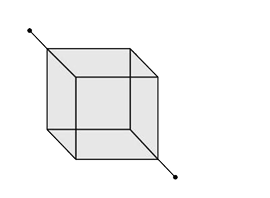Four conductors of same resistance connected to form a square. If the resistance between diagonally opposite corners is 8 ohm, the resistance between any two adjacent corners is
32 ohm
8 ohm
16 ohm
6 ohm
The correct Answer is:D
To solve the problem, we need to find the resistance between two adjacent corners of a square formed by four conductors of the same resistance. We know that the resistance between diagonally opposite corners is 8 ohms. Let's denote the resistance of each conductor as R.
1. Understanding the Configuration:
- We have four resistors arranged in a square. Let's label the corners as A, B, C, and D.
- The resistors are as follows:
- AB = R
- BC = R
- CD = R
- DA = R
2. Resistance Between Diagonal Corners:
- The resistance between diagonally opposite corners A and C (or B and D) is given as RAC=8Ω.
3. Finding the Equivalent Resistance:
- The resistors AB and CD are in series, and the resistors BC and DA are also in series.
- Therefore, the equivalent resistance for each pair is:
RAB+RCD=R+R=2R
RBC+RDA=R+R=2R
4. Parallel Combination:
- Now, the two series combinations (2R and 2R) are in parallel between points A and C:
RAC=(2R)×(2R)(2R)+(2R)=4R24R=R
- We know that RAC=8Ω, so:
R=8Ω
5. Finding Resistance Between Adjacent Corners:
- Now we need to find the resistance between two adjacent corners, say A and B.
- The resistance RAB is simply the resistance of one resistor:
RAB=R=8Ω
Final Answer:
The resistance between any two adjacent corners is 8Ω.
- We have four resistors arranged in a square. Let's label the corners as A, B, C, and D.
- The resistors are as follows:
- AB = R
- BC = R
- CD = R
- DA = R
- The resistance between diagonally opposite corners A and C (or B and D) is given as RAC=8Ω.
- The resistors AB and CD are in series, and the resistors BC and DA are also in series.
- Therefore, the equivalent resistance for each pair is:
RAB+RCD=R+R=2R
RBC+RDA=R+R=2R
- Now, the two series combinations (2R and 2R) are in parallel between points A and C:
RAC=(2R)×(2R)(2R)+(2R)=4R24R=R
- We know that RAC=8Ω, so:
R=8Ω
- Now we need to find the resistance between two adjacent corners, say A and B.
- The resistance RAB is simply the resistance of one resistor:
RAB=R=8Ω
The resistance between any two adjacent corners is 8Ω.
Topper's Solved these Questions
- CURRENT ELECTRICITYBOOK - NARAYNACHAPTER - CURRENT ELECTRICITYEXERCISE - Level 1 H.W
63 Videos
- CURRENT ELECTRICITYBOOK - NARAYNACHAPTER - CURRENT ELECTRICITYEXERCISE - Level 2 C.W
59 Videos
- CURRENT ELECTRICITYBOOK - NARAYNACHAPTER - CURRENT ELECTRICITYEXERCISE - C.U.Q
105 Videos
- COMMUNICATION SYSTEMBOOK - NARAYNACHAPTER - COMMUNICATION SYSTEMEXERCISE - Level-II(H.W)
25 Videos
- DUAL NATURE OF RADIATION AND MATTERBOOK - NARAYNACHAPTER - DUAL NATURE OF RADIATION AND MATTEREXERCISE - ASSERTION AND REASON
15 Videos
Similar Questions
Twelve resistors of equal value R are connected in the form of a cube. Effective resistance between diagonals of the cube is

View SolutionTwelve wires of equal length and same cross-section are connected in the form of a cube. If the resistance of each of the wires is R, and the effective resistance between the two diagonal ends is Re, then the ratio RRe is equal to __.

View Solution
Knowledge Check
Four conductors of same resistance connected to form a square. If the resistance between diagonally opposite corners is 8ohm, the resistive between any two adjacent corners is
A32 ohmB8 ohmC16 ohmD6 ohm
In the network shown, each resistance is equal to R. The equivalent resistance between diagonally opposite corners isARBR/3C2R/3D4R/3Twelve wires, each of resistance 6Ω are connected to form a cube. The effective resistance between two diagonally opposite corners of the cube is
A6ΩB12ΩC5ΩD10Ω
A metallic wire of resistance 12Ω is bent to form a square. The resistance between two diagonal points would be
View SolutionA metallic wire of resistance 12Ω is bent of form a square. The resistance between two diagonal points would be
View SolutionThree resistance each of 4Ω are connected to form a triangle. The resistance between any two terminals is
View SolutionFour wires of equal length and of resistance 5ohm each are connected in the form of a square. The equivalent resistance between the diagonally opposite corners of the square is
View SolutionFour resistances of 100Ω each are connected in the form of square. Then, the effective resistance along the diagonal points is
View Solution
